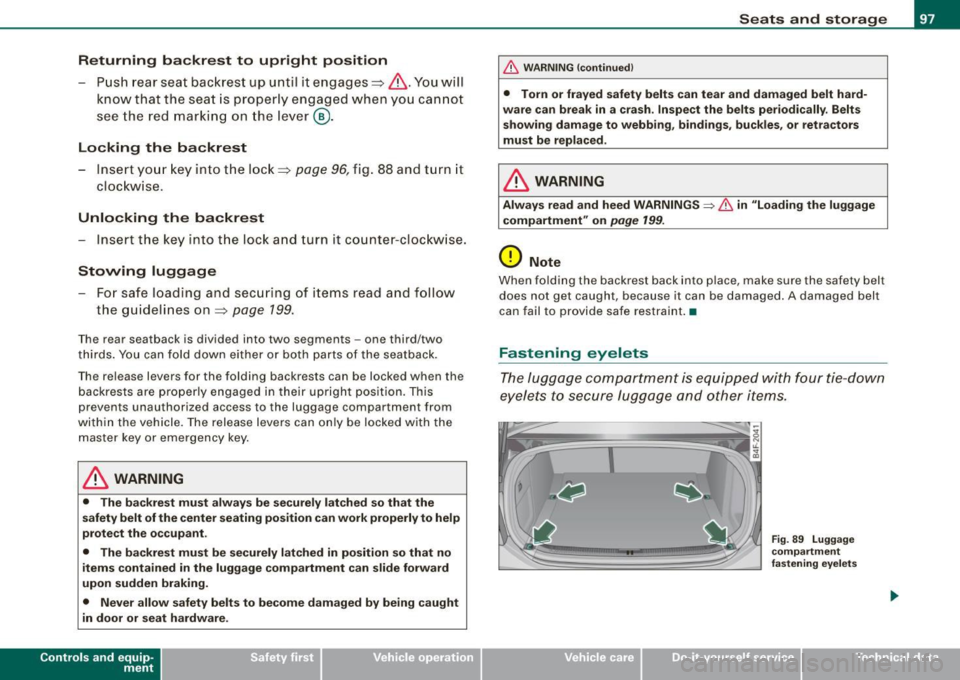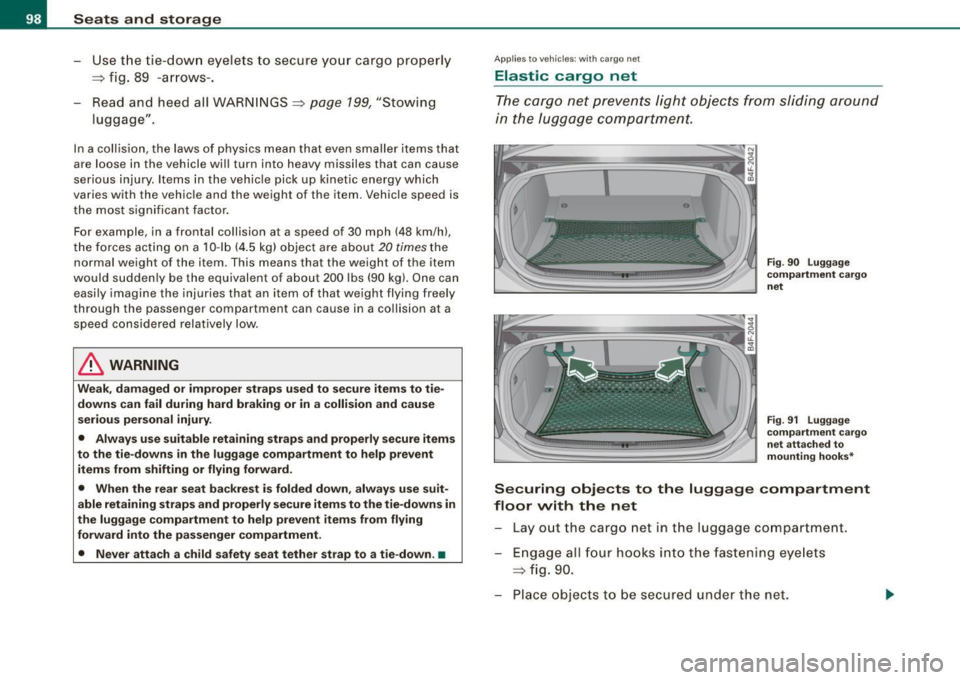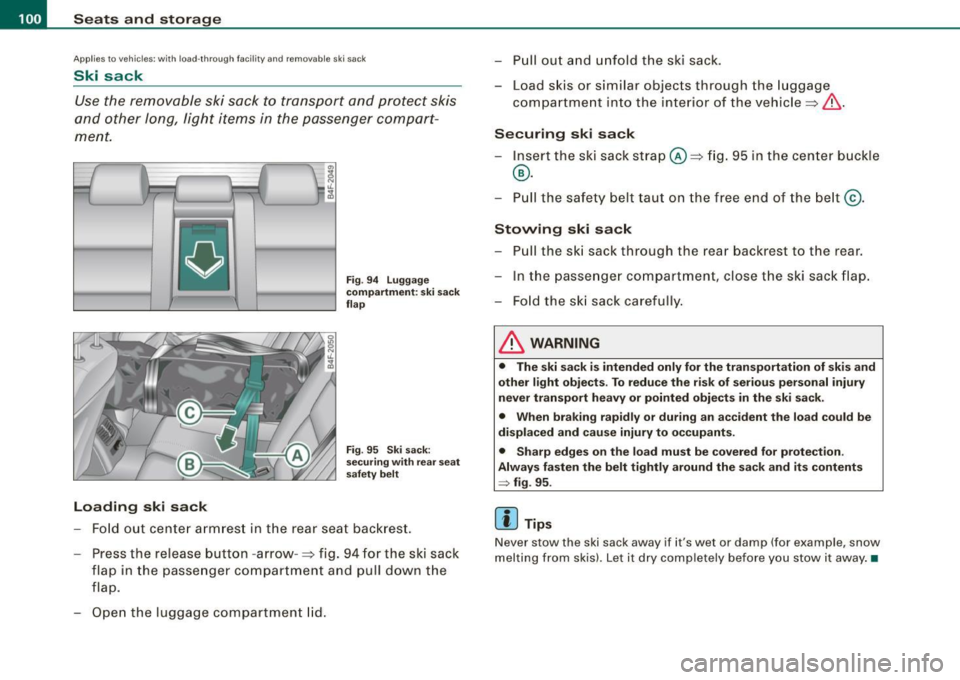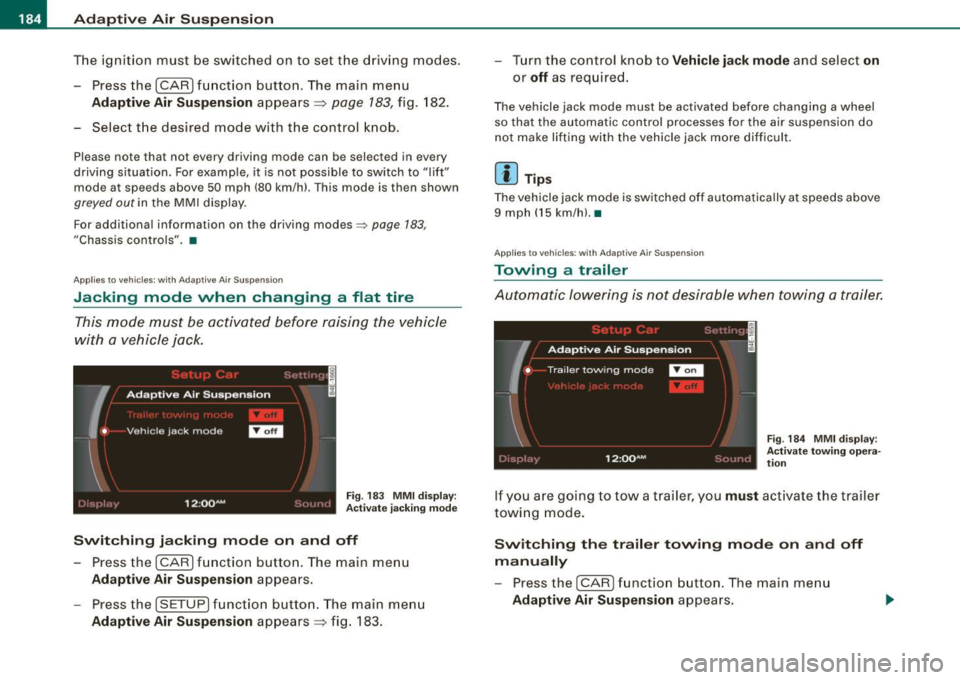2008 AUDI S6 towing
[x] Cancel search: towingPage 5 of 390

Safety first ........ ... ... .. .
Driving Safely ................. .
General notes ... .............. .
Proper occupant seating positions Peda l area ... ..... ....... .... . .
Sto\Ning luggage . .... .... .... . .
Reporting safety defects ....... .
Safety belts .......... ....... .. .
Genera l notes ...... ........... .
W hy safety belts? ............. .
Safety belts ............. ... .. .
Safety belt tensioners . ....• .. ..
Airbag system ........... ... .. .
Important things to kno\N ...... .
Front airbags . ... ... .......... .
Monitoring the Advanced Airbag
System ... .. ... .... ..... ..... .
Side airbags .......... ... ... .. .
Side curta in airbags (SIDEGUARD™l
Child Safety ................... .
191
192
192
194
198
199
201
202
202
203
206
210
212
212
216
223
228
231
234
Important things to kno\N . . . . . . . 234
Child safety seats . . . . . . . . . . . . . . 239
Install ing a ch ild safety seat . . . . . 244
Additional Information . . . . . . . . . . 247
Lo\Ner anchorages and tether for
children (LA TCH) . . . . . . . . . . . . . . . .
249
Vehicle operation . . . . . . . . 257
Intelligent technology . . . . . . . . . . 258
Notice about data recorded by
vehicle contro l modules . . . . . . . . .
258
Elect ronic Stabilizat ion Program
!ESP) . . . . . . . . . . . . . . . . . . . . . . . . . .
258
Braking . . . . . . . . . . . . . . . . . . . . . . . . 261
Servotronic® -advanced po\Ner
steer ing system . . . . . . . . . . . . . . . .
263
Driv ing \Nith your quattro® . . . . . . 264
Energy management . . . . . . . . . . . . 265
Driving and environment . . . . . . . 267
The first 1,000 miles (1,500 km) and
after\Nards . . . . . . . . . . . . . . . . . . . . .
267
Cata lytic converter . . . . . . . . . . . . . 268
Avoid damaging the vehicle . . . . . 269
Operate your vehicle economically
and minimize pollution . . . . . . . . . .
269
Trailer towing . . . . . . . . . . . . . . . . . . 272
Driv ing \Nith a trailer . . . . . . . . . . . . 272
Trai ler to\Ning tips . . . . . . . . . • . . . . 274
Table of contents
Vehicle care ....... ... ... ... 277
Cleaning and protection ........ 278
General information . . . . . . . . . . . . . 278
Care of exterior . . . . . . . . . . . . . . . . . 278
Care of inte rior . . . . . . . . . . . . . . . . . 285
Fuel supply and filling your fuel
tank ... .... ... .... ... .. .... ... .. 291
Gasoline . . . . . . . . • . . . . • . . . . . . . . . 291
Fuel tank . . . . . . . . . . . . . . . . . . . . . . . 292
Checking and filling . . . . . . . . . . . . 296
Engine hood . . . . . . . . . . . . . . . . . . . 296
Engine oil . . . . . . . . . . . . . . . . . . . . . . 299
Engine cooling syste1T1 . . . . . . . . . .
303
Brake fluid . . . . . . . . . . . . . . . . . . . . . 306
Battery . . . . . . . . . . . . . . . . . . . . . . . . 307
Windshield/headlight \Nasher
containe r .... .... .. ... .. .... ... 312
Tires and wheels ............... 313
Tires . . . . . . . . . . . . . . . . . . . . . . . . . . . 313
Vehicle care I I irechnical data
Page 6 of 390

Table of contents
Do-it-yourself service ... 335
What do I do now? . . . . . . . . . . . . . 336
Trunk escape handle . . . . . . . . . . . . 336
J ack, tools and spare wheel . . . . . . 336
Changing a whee l . . . . . . . . . . . . . . 338
Fuses and bulbs . . . . . . . . . . . . . . . . 345
Fuses . . . . . . . . . . . . . . . . . . . . . . . . . . 345
Bulbs ................... •...... 349
Em erge ncy s itua tions . . . . . . . . . . 351
Genera l ... ... ... ..... .... .. .... 351
Starting by pushing or towing . . . . 351
Start ing with jumpe r cab les . . . . . . 351
Use of junipe r cab les . . . . . . . . . . . . 352
E mergency tow ing with commerc ia l
t ow truck . . . . . . . . . . . . . . . . . . . . . . 354
Lifting vehicle . . . . . . . . . . . . . . . . . . 356
Technical data
General in format ion
Explanat ion of t echnical data ... .
Vehic le iden tif ic ation .... ....... .
Display ing Vehic le Identification
Number in the MMI ..... .. .. ... . 359
360
360
360
361 Weights . .
. . . . . . . . . . . . . . . . . . . . . 361
Dimensions . . . . . . . . . . . . . . . . . . . . 362
Data . . . . . . . . . . . . . . . . . . . . . . . . . . . 363
255 hp, 6-cylinder eng ine
363
350 hp, 8-cylinder engine . . . . . . . 364
Co ns umer In forma tion . . . . . . . . . 365
War ranty coverages ......... .. .
Reporting safety defects ....... .
Operating your vehicle outs ide the
U.S.A . or Canada .............. .
Audi Service Repa ir Manuals and
Liter ature ..................... .
Main tenance .............. ... .
Additional accessories ,
modif icat ions and parts
rep lacement ............... ... . 365
365
365
366
366
368
Alphabetical index
. . . . . . 371
Page 76 of 390

Clear vision
[ i J Tips
You should turn on the emergency flashers when:
• you are the last vehicle standing in a traffic jam so that any other
vehicles coming can see you, or when
• your vehicle has broken down or you are in an emergency situa
tion, or when
• your vehicle is being towed by a tow truck or if you are towing
another vehicle behind you. •
Turn signal ¢ ¢ and high beam ~D lever
The lever on the left side of the steering column is used to
operate the turn signals and the high beam as well as the
headlight flasher.
Fig . 60 Turn signa l and
high beam lever
The turn signal and high beam lever has the following func
tions :
Turn signals ¢ ¢
- Lift the lever up all the way=:> fig . 60 to use the right turn
signals, or push the lever down all the way to use the left
turn signals.
Auto -blink
- Move the lever (up or down) just to the point of resis
tance to use the turn signals for as long as you need
them, for example when changing lanes .
- Move the lever (up or down) just to the point of resis
tance and then release it right away to make the turn
signals blink
three times . You can use this feature for
example when changing lanes on highways.
High beam ~D
- Push the lever forward to switch on the high beam.
- Pull the lever back towards you to switch off the high
beam .
Headlight flasher ~D
Pull the lever toward the steering wheel to use the head
light flasher.
Notes on these features
• The turn signals only work with the ignition turned on. The indi
cator lights ¢ or¢ in the instrument cluster::::;, page 17 also blink.
• After you have turned a corner, the turn signal switches off auto
matically.
• The high beam works only when the head lights are on . The indi
cator light ~D in the instrument cluster illuminates when the high
beams are on.
• The headligh t flasher works only as long as you hold the lever -
even if there are no lights turned on. The indicator light ~Din the
instrument cluster illuminates when you use the headlight flasher. _.,
Page 99 of 390

Returning backrest to upright position
-Pu sh rear seat back rest up until it engages~ &. You will
know that the sea t is proper ly engaged when you can not
see the red marki ng on the lever ®·
Locking the backrest
- Insert yo ur key into t he lock~ page 96, fig. 88 and t urn it
cloc kwise.
Unlocking the backrest
- Inse rt th e key i nto the lock a nd tu rn it co unter-cloc kw ise.
Stowing luggage
- For safe loading and securing of i tems read and follow
the guidelines on~ page 199.
The rear seatback is divided into two segments -one thi rd/two
thirds . You can fold down either or both parts o f the seatback.
T he release levers for the fold ing backrests can be locked when the
backrests are pro pe rly engaged in their up right pos itio n. This
prevents unauthorized access to the luggage compartment from
with in the veh icle. The release levers can on ly be locked with the
master key or emer gency key.
& WARNING
• The ba ck rest must al ways be securely lat ched so that the
safety b elt of the center seating position can work properly to help
protect the o ccupant .
• The backre st must be securely latched in po sition so that no
items contained in the luggage compartment can slide forward
upon sudden brak ing .
• Never allow safety belt s to be come damaged by being caught
in door or seat hardware .
Con tro ls and eq uip
ment
Seats and storag e
& WARNING !continued )
• Torn or frayed safety belts can tear and damaged belt hard
ware can b reak in a cra sh . Inspect the belts periodically . B elt s
showing damage to webbing , bindings, buckles , or retractor s
must be replaced .
& WARNING
Always read and heed WARNINGS ::::;, & in "Loading the luggage
c ompartment " on
page 199.
(D Note
When fo lding the backrest back into p lace, make sure the safety belt
does not get caught, because it can be damaged. A damaged belt
can fail to provide safe restraint . •
Fastening eyelets
T he luggage compartment is equipped with four tie -down
eyelets to secure lugga ge and other items.
Vehicle care I I
Fig . 8 9 Luggage
co mp artment
fastening eye lets
irechnical data
Page 100 of 390

Seats and storage
- Use the tie-down eyelets to secure your cargo properly
=> fig. 89 -arrows-.
Read and heed all WARNINGS=>
page 199, "Stowing
luggage".
In a collision, the laws of physics mean that even smaller items that
are loose in the vehicle will turn into heavy missiles that can cause
serious injury. Items in the vehicle pick up kinetic energy which
varies w ith the vehicle and the weight of the item. Vehicle speed is
the most significant factor.
For example , in a frontal collision a t a speed of 30 mph (48 km/h),
the forces acting on a 10 -lb (4.5 kg) object are about
20 times the
normal weight of the item . This means that the weight of the item
would suddenly be the equivalent of about 200 lbs (90 kg). One can
easily imagine the injuries that an item of that weight flying freely
through the passenger compartment can cause in a collision at a
speed considered relatively low .
& WARNING
Weak, damaged or improper straps used to secure items to tie
downs can fail during hard braking or in a collision and cause
serious personal injury.
• Always use suitable retaining straps and properly secure items
to the tie-downs in the luggage compartment to help prevent
items from shifting or flying forward.
• When the rear seat backrest is folded down, always use suit
able retaining straps and properly secure items to the tie-downs in
the luggage compartment to help prevent items from flying
forward into the passenger compartment.
• Never attach a child safety seat tether strap to a tie-down. •
App lies to veh ic les: with cargo net
Elastic cargo net
The cargo net prevents light objects from sliding around
in the luggage compartment.
Fig . 90 Luggage
compartment cargo
net
Fig. 91 Luggage
compartment cargo
net attached to
mounting hooks*
Securing objects to the luggage compartment
floor with the net
Lay out the cargo net in the luggage compartment .
Engage all four hooks into the fastening eyelets
=> fig. 90.
Place objects to be secured under the net.
Page 102 of 390

-L---S=..:: e...:a :.. t::..: s:......: a::..: n~ d:...:: s...:t ...:o ...:r...: a:.:..: g~ e ________________________________________________ _
Applies to vehicles: wi th load- through facility and removab le s ki sack
Ski sack
Use the removable ski sack to transport and protect skis
and other Jong, light items in the passenger compart
ment.
Loading ski sack
Fig . 94 Luggage
compartment: ski sack
flap
Fig . 95 Ski sack:
securing with rear seat
safety belt
Fold out center armrest in the rear seat backrest.
- Press the release button -arrow -=> fig. 94 for the ski sack
flap in the passenger compartment and pull down the
flap.
- Open the luggage compartment lid. -
Pull out and unfold the ski sack.
- Load skis or similar objects through the luggage
compartment into the interior of the vehicle =>
&-
Securing ski sack
- Insert the ski sack strap@=> fig. 95 in the center buckle
@.
- Pull the safety belt taut on the free end of the belt @.
Stowing ski sack
- Pull the ski sack through the rear backrest to the rear.
- In the passenger compartment, close the ski sack flap.
- Fold the ski sack carefully.
& WARNING
• The ski sack is intended only for the transportation of skis and
other light objects . To reduce the risk of serious personal injury
never transport heavy or pointed objects in the ski sack.
• When braking rapidly or during an accident the load could be
displaced and cause injury to occupants.
• Sharp edges on the load must be covered for protection .
Always fasten the belt tightly around the sack and its contents
~ fig. 95 .
[ i ] Tips
Never stow the ski sack away if it's wet or damp (for example, snow
melting from skis). Let it dry completely before you stow it away. •
Page 129 of 390
![AUDI S6 2008 Owners Manual On th e road -_________________________________ __::..:....:.......;,;_;_;_ _ __;____,J
Switching the ignition on
- Press t he [ S TART] button once to the first stage to switch
on on AUDI S6 2008 Owners Manual On th e road -_________________________________ __::..:....:.......;,;_;_;_ _ __;____,J
Switching the ignition on
- Press t he [ S TART] button once to the first stage to switch
on on](/manual-img/6/57596/w960_57596-128.png)
On th e road -_________________________________ __::..:....:.......;,;_;_;_ _ __;____,J
Switching the ignition on
- Press t he [ S TART] button once to the first stage to switch
on on ly the ignition.
Starting the engine
- Step on t he brake.
- Move the se lector leve r to t he P or N posit ion
~ & .
- Press the [ STA RT ] button to t he second s tage to star t the
engine.
After a cold engine is started, there may be a brief period of
increased noise because oil pressure must first bui ld up in the
hydraulic valve adjusters . This is norma l and not a cause for
concern.
If the engine does not start immed iately, stop trying after 10
seconds and then try to restart the engine about 30 seconds later.
& WARNING
Ne ver all ow the e ngine to run in confined spa ce s -danger of
asphyxi atio n.
0 Note
• Avo id high engi ne rp m, full throttle and heavy engine loads unti l
the engine has reached operating temperature -otherwise you risk
engine damage .
• T he engine cannot be started by pushing or towing the vehic le.
c£> For the sake of the environment
Do not allow the engine to warm up with the vehicle stationary . Start
driving right away . In this way you avo id unnecessary emissions .
Contro ls and eq uip
ment
[ i ] Tip s
If you open the driver's door when t he ign itio n is switched on, a
buzzer sounds and the message
Ign ition i s on appears in the instru
ment cluster display. P lease switch the ignition off. •
Applies to vehic le s: with Adva nced Key
Switching engine off with the [STOP] button
Bring yo ur vehicle to a comp le te sto p.
Fig. 12 5 Advan ced
Key: E NGIN E STO P
button
Move the se lector lever to the P o r N position .
Press the [
STOP I button ~ fig . 125.
Pressing the ( STO P] button once switches off the engine and the
ignition . If you press the ( S T OP! button again for more than 1
second, the steering is locked, provided that the selector leve r is in
the P position
~ & .
Emergency OFF function
If necessary , the engine can be switched off with the selector leve r
in the R, Dor S positions. To do so, step on the brake peda l and
press and hold the ( STOP] button (vehicle speed must be less than
6 mph/ 10 km /h. .,,_
Vehicle care I I irechnical data
Page 186 of 390

• ..__A_ d_ a--=- p_t _iv _ e_ A_ i_ r _ S_ u_ s....; p=--- e_n_ s_ io_ n _____________________________________________ _
The ignition must be switched on to set the driving modes.
- Press the !CARI function button. The main menu
Adaptive Air Suspension appears=>
page 183, fig. 182.
- Select the desired mode with the control knob.
Please note that not every driving mode can be selected in every
driving situation. For example, it is not possible to switch to "lift"
mode at speeds above 50 mph (80 km/h). This mode is then shown
greyed out in the MMI display.
For additional information on the driving modes=>
page 183,
"Chassis controls". •
Applies to vehicles: with Adaptive Air Suspension
Jacking mode when changing a flat tire
This mode must be activated before raising the vehicle
with a vehicle jack.
Fig. 183 MMI display :
Activate jacking mode
Switching jacking mode on and off
-Press the (CAR] function button. The main menu
Adaptive Air Suspension appears.
- Press the !SETUP) function button. The main menu
Adaptive Air Suspension appears=> fig. 183. - Turn the control knob to
Vehicle jack mode and select on
or
off as required.
The vehicle jack mode must be activated before changing a wheel
so that the automatic control processes for the air suspension do
not make lifting with the vehicle jack more difficult.
[ i ] Tips
The vehicle jack mode is switched off automatically at speeds above
9 mph (15 km/h).•
Applies to vehicles: with Adaptive Air Suspension
Towing a trailer
Automatic lowering is not desirable when towing a trailer.
Fig. 184 MMI display:
Activate towing opera
tion
If you are going to tow a trailer, you must activate the trailer
towing mode.
Switching the trailer towing mode on and off
manually
- Pressthe!CARJfunction button. The main menu
Adaptive Air Suspension appears.